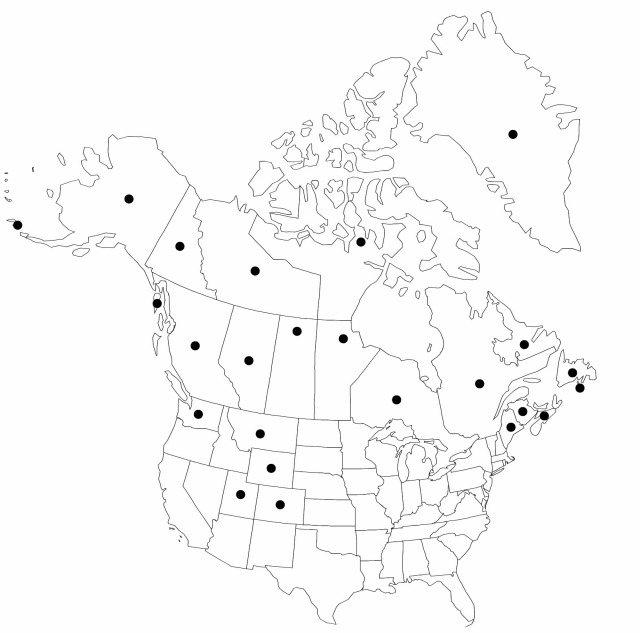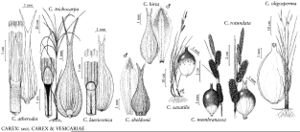Difference between revisions of "Carex saxatilis"
Sp. Pl. 2: 976. 1753.
FNA>Volume Importer |
TammyCharron (talk | contribs) |
||
| (7 intermediate revisions by 2 users not shown) | |||
| Line 8: | Line 8: | ||
}} | }} | ||
|common_names=Carex saxatile | |common_names=Carex saxatile | ||
| + | |special_status={{Treatment/ID/Special_status | ||
| + | |code=F | ||
| + | |label=Illustrated | ||
| + | }} | ||
|basionyms= | |basionyms= | ||
|synonyms={{Treatment/ID/Synonym | |synonyms={{Treatment/ID/Synonym | ||
|name=Carex ambusta | |name=Carex ambusta | ||
|authority=Boott | |authority=Boott | ||
| − | + | |rank=species | |
| − | | | + | }} {{Treatment/ID/Synonym |
| − | |||
| − | }}{{Treatment/ID/Synonym | ||
|name=Carex miliaris | |name=Carex miliaris | ||
|authority=Michaux | |authority=Michaux | ||
| − | }}{{Treatment/ID/Synonym | + | |rank=species |
| + | }} {{Treatment/ID/Synonym | ||
|name=Carex physocarpa | |name=Carex physocarpa | ||
|authority=C. Presl | |authority=C. Presl | ||
| − | }}{{Treatment/ID/Synonym | + | |rank=species |
| + | }} {{Treatment/ID/Synonym | ||
|name=Carex rhomalea | |name=Carex rhomalea | ||
|authority=(Fernald) Mackenzie | |authority=(Fernald) Mackenzie | ||
| + | |rank=species | ||
| + | }} {{Treatment/ID/Synonym | ||
| + | |name=Carex vesicaria var. compacta | ||
| + | |authority=Kükenthal | ||
| + | |rank=variety | ||
}} | }} | ||
|hierarchy=Cyperaceae;Carex;Carex sect. Vesicariae;Carex saxatilis | |hierarchy=Cyperaceae;Carex;Carex sect. Vesicariae;Carex saxatilis | ||
| Line 39: | Line 48: | ||
|elevation=0–3700 m | |elevation=0–3700 m | ||
|distribution=Greenland;St. Pierre and Miquelon;Alta.;B.C.;Man.;N.B.;Nfld. and Labr.;N.W.T.;N.S.;Nunavut;Ont.;Que.;Sask.;Yukon;Alaska;Colo.;Maine;Mont.;Utah;Wash.;Wyo.;Eurasia. | |distribution=Greenland;St. Pierre and Miquelon;Alta.;B.C.;Man.;N.B.;Nfld. and Labr.;N.W.T.;N.S.;Nunavut;Ont.;Que.;Sask.;Yukon;Alaska;Colo.;Maine;Mont.;Utah;Wash.;Wyo.;Eurasia. | ||
| − | |discussion=<p>Carex saxatilis is highly variable in North America. Plants from western North America, often named C. physocarpa, tend to be robust with long peduncles on the pistillate spikes, wide leaves, and large perigynia. These characters decrease in size eastward across North America with successively smaller plants usually referred to as C. saxatilis and C. miliaris. This weak east/west cline is confounded by large amounts of variation within small geographic areas and phenotypic plasticity. B. A. Ford et al. (1991) and B. A. Ford and P. W. Ball (1992) have demonstrated that these segregates represent elements in a continuum rather than discrete taxa.</p><!-- | + | |discussion=<p><i>Carex saxatilis</i> is highly variable in North America. Plants from western North America, often named C. physocarpa, tend to be robust with long peduncles on the pistillate spikes, wide leaves, and large perigynia. These characters decrease in size eastward across North America with successively smaller plants usually referred to as <i>C. saxatilis</i> and C. miliaris. This weak east/west cline is confounded by large amounts of variation within small geographic areas and phenotypic plasticity. B. A. Ford et al. (1991) and B. A. Ford and P. W. Ball (1992) have demonstrated that these segregates represent elements in a continuum rather than discrete taxa.</p><!-- |
| − | --><p>Hybrids between Carex saxatilis and C. vesicaria (= C. ×stenolepis Lessing; = C. ×mainensis Porter ex Britton) and C. saxatilis and C. utriculata (= C. ×physocarpoides Lepage) have been found in North America (B. A. Ford et al. 1993). These hybrids are infrequent, largely sterile, and intermediate in morphology between the two parents.</p> | + | --><p>Hybrids between <i>Carex saxatilis</i> and <i>C. vesicaria</i> (= C. ×stenolepis Lessing; = C. ×mainensis Porter ex Britton) and <i>C. saxatilis</i> and <i>C. utriculata</i> (= C. ×physocarpoides Lepage) have been found in North America (B. A. Ford et al. 1993). These hybrids are infrequent, largely sterile, and intermediate in morphology between the two parents.</p><!-- |
| + | --><p><i>Carex compacta</i> R. Brown ex Dewey (1835, not Lamarck, 1779) is an illegitimate name that pertains here.</p> | ||
|tables= | |tables= | ||
|references= | |references= | ||
| Line 49: | Line 59: | ||
-->{{#Taxon: | -->{{#Taxon: | ||
name=Carex saxatilis | name=Carex saxatilis | ||
| − | |||
|authority=Linnaeus | |authority=Linnaeus | ||
|rank=species | |rank=species | ||
|parent rank=section | |parent rank=section | ||
| − | |synonyms=Carex ambusta | + | |synonyms=Carex ambusta;Carex miliaris;Carex physocarpa;Carex rhomalea;Carex vesicaria var. compacta |
|basionyms= | |basionyms= | ||
|family=Cyperaceae | |family=Cyperaceae | ||
| Line 63: | Line 72: | ||
|publication title=Sp. Pl. | |publication title=Sp. Pl. | ||
|publication year=1753 | |publication year=1753 | ||
| − | |special status= | + | |special status=Illustrated |
| − | |source xml=https:// | + | |source xml=https://bitbucket.org/aafc-mbb/fna-data-curation/src/2e0870ddd59836b60bcf96646a41e87ea5a5943a/coarse_grained_fna_xml/V23/V23_934.xml |
|genus=Carex | |genus=Carex | ||
|section=Carex sect. Vesicariae | |section=Carex sect. Vesicariae | ||
Latest revision as of 16:58, 25 April 2022
Plants usually loosely cespitose; rhizomes short, congested. Culms trigonous in cross section, 8–90 cm, scabrous distally. Leaves: basal sheaths reddish brown; ligules as wide as to slightly longer than wide; blades mid to dark green, V-shaped, sometimes with revolute margins, 0.9–6.3 mm wide, glabrous. Inflorescences 2.5–14(–20) cm; proximal bract 0.6–16(–29) cm, shorter than or equaling inflorescence; proximal 1–3 spikes pistillate, erect or the proximal often pendent; terminal 1–3 spikes staminate. Pistillate scales ovate, 1.9–4.3(–5) × 0.9–2.1 mm, as long as or shorter than perigynia, margins entire, apex obtuse or acute, awnless. Perigynia ascending, often dark-colored, obscurely few-veined, veins not running to beak, tightly investing achene, elliptic, 2.2–5.5 × 1.1–2.9 mm, apex abruptly contracted; beak 0.2–0.8 mm, bidentulate, teeth straight, to 0.3 mm. Stigmas 2. Achenes yellow, biconvex, smooth. 2n = 78, 80.
Phenology: Fruiting summer.
Habitat: Fens, bogs, wet tundra, roadside ditches, shores of lakes, ponds, and slow moving streams, often in shallow water
Elevation: 0–3700 m
Distribution

Greenland, St. Pierre and Miquelon, Alta., B.C., Man., N.B., Nfld. and Labr., N.W.T., N.S., Nunavut, Ont., Que., Sask., Yukon, Alaska, Colo., Maine, Mont., Utah, Wash., Wyo., Eurasia.
Discussion
Carex saxatilis is highly variable in North America. Plants from western North America, often named C. physocarpa, tend to be robust with long peduncles on the pistillate spikes, wide leaves, and large perigynia. These characters decrease in size eastward across North America with successively smaller plants usually referred to as C. saxatilis and C. miliaris. This weak east/west cline is confounded by large amounts of variation within small geographic areas and phenotypic plasticity. B. A. Ford et al. (1991) and B. A. Ford and P. W. Ball (1992) have demonstrated that these segregates represent elements in a continuum rather than discrete taxa.
Hybrids between Carex saxatilis and C. vesicaria (= C. ×stenolepis Lessing; = C. ×mainensis Porter ex Britton) and C. saxatilis and C. utriculata (= C. ×physocarpoides Lepage) have been found in North America (B. A. Ford et al. 1993). These hybrids are infrequent, largely sterile, and intermediate in morphology between the two parents.
Carex compacta R. Brown ex Dewey (1835, not Lamarck, 1779) is an illegitimate name that pertains here.
Selected References
None.
